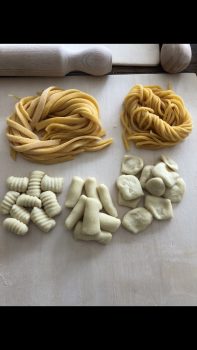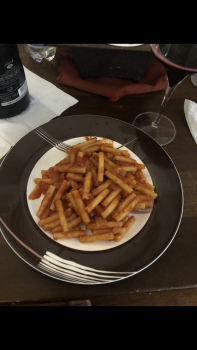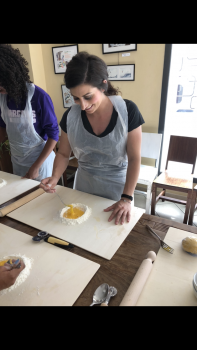Una ricetta semplicissima Posted by Bridgette on Aug 7, 2019 in Culture, Italian Language
Il cibo italiano, dicevamo!
Qual è (questa regola italiana di non usare l’apostrofo quando si scrive qual è non l’ho mai capita…) la miglior cucina al mondo? Beh, facile, quella italiana.
Which is (I’ve never understood this Italian rule of not using the apostrophe when you write qual è…) the best cuisine in the world? Easy, Italian.
Ecco quindi alcuni brevi consigli per cucinare un’ottima pasta, e stupire i vostri amici. E’ una ricetta molto semplice che mi ha insegnato uno dei miei italiani preferiti: la pasta al pomodoro e basilico.
Here is some quick advice on how to cook an amazing pasta, and amaze your friends. It’s a very simple recipe that one of my favorite Italians taught me: pasta with tomato and basil.
Per iniziare bisogna mettere a bollire una pentola d’acqua (circa 2/3 litri) e lasciare che raggiunga la temperatura di 100° C (212 °F). Per risparmiare tempo potete coprirlo con un coperchio. Un consiglio: mettete il sale in acqua solo quando avrà raggiunto la temperatura, così dovrete aspettare meno tempo.
To begin, you will need to boil a pot of water (around 2/3 of a liter) and let it reach the temperature 100° C (212 °F). To save time you can it with a lid. Some advice: add salt only when it reaches that temperature, as such you will not have to wait as long.
In un’altra pentola tagliate finemente la cipolla e mettete un filo di olio extra vergine d’oliva. In questo modo state preparando il soffritto.
In another pan, finely dice the onion and put a bit of extra virgin olive oil. This way, you are preparing the “soffritto” (sautéed vegetables.)
Dopo qualche minuto, quando vedete che inizia a diventare dorata (del colore oro), mettete la passata di pomodoro (vanno bene anche dei pezzi di pomodori se non avete la passata) e lasciate cuocere per alcuni minuti, finché il pomodoro diventa più denso. Qui otterrete un bene molto prezioso: il sugo.
After a few minutes, when you see that it is beginning to become golden (from the color gold), put the tomate puree (if you don’t have tomate puree, pieces of tomato will work as well) and let it cook for a few minutes, until the tomatoes become more firm. Here you will have a very valuable asset: the sauce.
Aggiungete un po’ di sale, pochissimo zucchero (ecco il mio segreto, ma veramente pochissimo, meno della metà di un cucchiaino piccolo), un po’ di peperoncino, e le foglie di basilico. Spegnete il fuoco e concentratevi sulla pentola d’acqua, che a questo punto dovrebbe essere arrivata a temperatura.
Add a bit of salt, a tiny bit of sugar (here is my secret, but really a tiny bit, less than half of a teaspoon), a bit of peperoncino, and basil leaves. Turn off the heat and concentrate on the pot of water, because at this point it should have arrived at the right temperature.
Ora la scelta più difficile: il tipo di pasta da buttare (cioè mettere nell’acqua).
Now the most difficult choice: the type of pasta to throw in (that is, put in the water).
Potete scegliere tra pasta corta -fusilli, farfalle, penne, pasta fatta in casa, o pasta lunga come spaghetti, linguine ecc. Io amo i bucatini, una forma particolare di spaghetti.
You can choose between short pasta – fusilli, farfalle, penne, homemade pasta, or long pasta such as spaghetti, linguine, etc. I love bucatini, a particular form of spaghetti.

Guardate il tempo di cottura scritto sulla confezione e buttate la pasta: a me piacciono “al dente” cioè non troppo cotti. E questo è un altro segreto della pasta: per tradizione va mangiata al dente.
Check the time of cooking written on the packaging and throw in the pasta: I prefer “al dente”, that is not too cooked. And this is another secret of pasta: traditionally it is eaten al dente.
Quindi 1 minuto prima della cottura toglieteli dalla pentola e li “scolate”, aggiungendoli poi all’altra pentola contenente il sugo al pomodoro.
Then one minute before being fully cooked take it from the pot and drain it, adding it then to the other pan containing the tomato sauce.
Tenete la pentola a fuoco molto basso, girate il contenuto per un minuto, aggiungete un altro filo di olio, grattugiate il parmigiano, e…gustate la vostra creazione!
Keep the fire on the pan low, turn the contents for a minute, add another splash of olive oil, grate the parmesan, and… taste your creation!
Buon appetito!


Build vocabulary, practice pronunciation, and more with Transparent Language Online. Available anytime, anywhere, on any device.





Comments:
NINI RUKMINI:
Yes, buona petito.
Karen Hutchison:
Mia cugina mi ha insegnata ad aggiungere una carota tagliata piccola piccola invece dello zucchero. Si può aggiungere anche del sedano.
Ali Brown:
Benissimo! Voglio provare questa ricetta questa fine settimana.
Grazie!
Avete una ricetta per la pasta della casa: fresh pasta?
D’anne:
Grazie mille per condividendo tua ricetta preferita, yummy. Anche, ho imparato il nuovo vocabolario della cucina.
Christine Percival:
Grazie mille, Bridgette!
Molto bene! I do have a question. When I was in Roma 2 years ago, we had lunch at an authentic trattoria. I spoke enough Italian to be able to engage with the server about the preparation of the pasta with the tomato sauce. He shared with me these thoughts: “In Italia, we take fresh tomatoes and simmer them for an hour to make the sauce, also including aromatics like onion, carrot. It simmers very very slowly. Then if the sauce is too acidic, we do not add sugar ~~ we add whole milk because milk has a sweetness to it and it reduces the acidity dramatically.” I went home and tried this and found it to be true. It was heavenly and I stopped adding even the smallest amt. of sugar. Milk works great. What do you think about that?
Bridgette:
@Christine Percival That sounds like a great idea, Christine! I haven’t seen the addition of milk instead of sugar.. I’m going to have to try that next time and share the idea with my Italian friend who shared this recipe with me. Thank you!